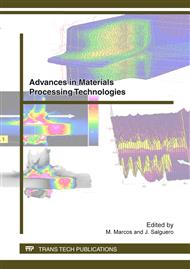p.73
p.79
p.85
p.91
p.97
p.103
p.109
p.115
p.121
Experimental Characterization of the Mechanical Behavior of Concrete Bars in the Tensile Test
Abstract:
Necking process stress and strain analysis, which is key to determine the plastic flow evolution in finite deformation, has been widely studied and applied to a number of materials based on the theories established by Davidenkov-Spiridnova and Bridgman in the 40s decade. These theories envolve from the study of necking geometry in fracture. In this paper, we develop an exhaustive experimental analysis of the stress and strain field in the necking process, applied to concrete bars and mechanized samples with similar features, in order to compare the results with the ones given by the theories listed above and to look for the corrugation influence in the materials plastic behavior.
Info:
Periodical:
Pages:
97-102
Citation:
Online since:
April 2012
Authors:
Keywords:
Price:
Сopyright:
© 2012 Trans Tech Publications Ltd. All Rights Reserved
Share:
Citation:


